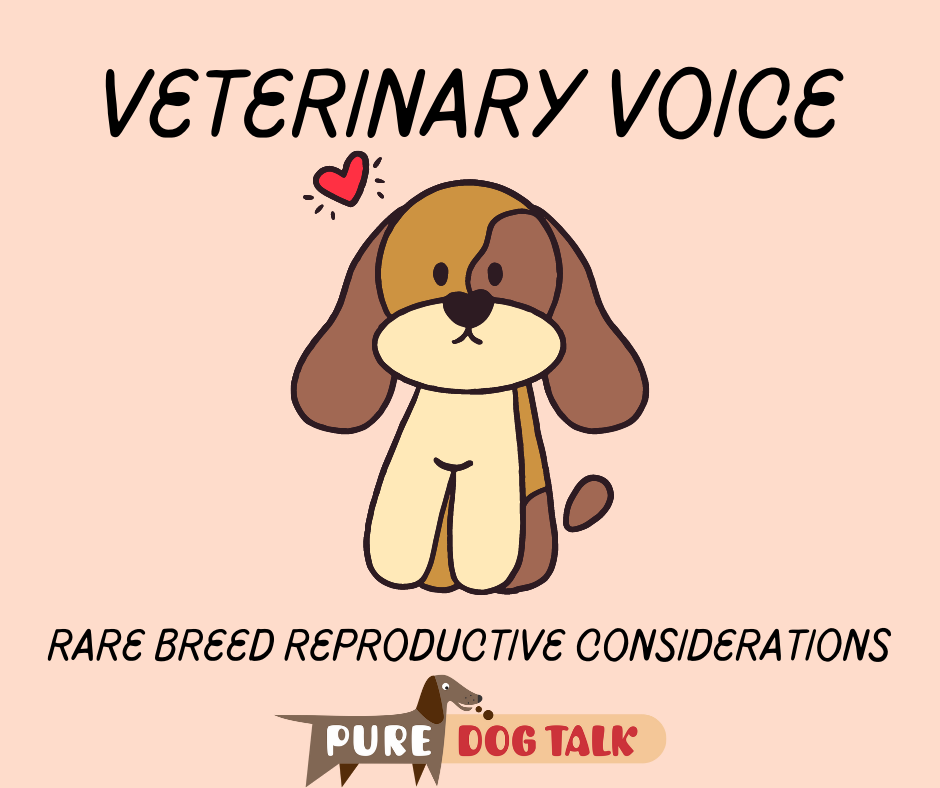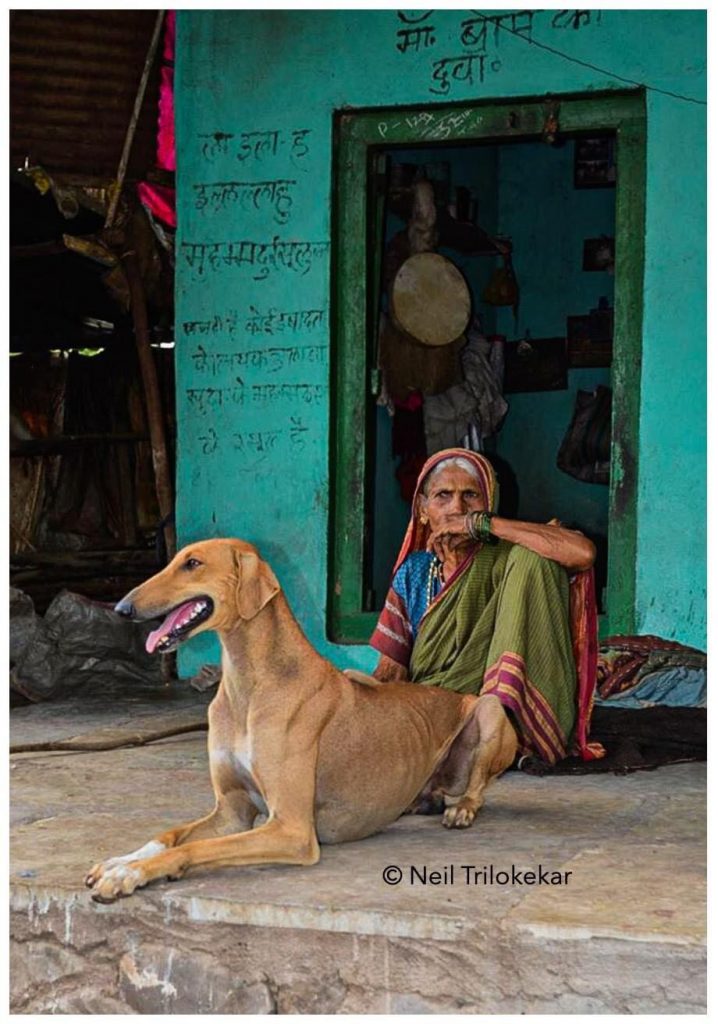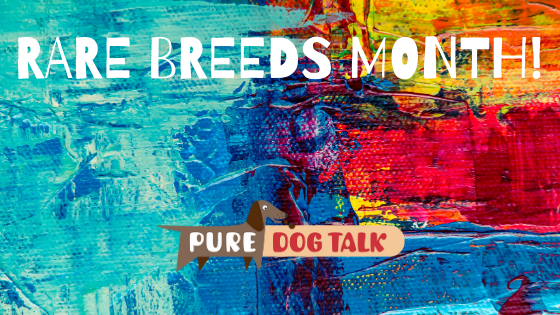523 – Special Reproductive Considerations for Rare Breeds
Special Reproductive Considerations for Rare Breeds
Dr. Marty Greer, DVM joins host Laura Reeves to discuss some of the special reproductive considerations for rare breeds. Rare dog breeds offer specific challenges for their breeders including health concerns, limited gene pools, DNA testing mazes and infertility issues.
April is Rare Breeds month here at Pure Dog Talk! Watch for upcoming episodes with deep dives into Norrbottenspets, Chinooks and Nederlandse Kooikerhondje.
“Pick one thing a year that you’re going to try to work through in your breed,” Greer said, quoting from Dr. Ian Dunbar. “Pick what your priorities are. You have to pick. I can’t pick for you. You know your breed. You know your genes. At some point we have to really say this is what I’m going to focus on, this is what I’m going to try to breed for or away from, and try to take those incremental steps. You’re not gonna get it all in one generation.”
How do you eat an elephant…
“I think that’s so important in the rare breed community to emphasize the you eat the elephant one bite at a time,” Reeves added. “It’s really important to recognize that and not get discouraged because you’re trying to swallow a whole elephant. Be committed to that long term process. From a rare breed perspective, that’s one of the things I always emphasize, this is not a fly by night operation. It’s a process, something you’re going to dedicate your entire life to.”
“You work with other people and you’re honest with other people,” Greer emphasized. “So we need to stop hiding things. We need to stop backbiting. We need to stop saying bad things about other people and we need to be really honest with each other and with ourselves so that when you look in the mirror you can say ‘I’m breeding the best dog that I possibly can.’
Full disclosure
“Nobody goes out and deliberately breeds a bad dog but there’s so many aspects to how you have to make these decisions. Without full disclosure you really can’t get there. So we have to be honest with each other. No breeder deliberately produced a dog with a genetic problem, but you’ve got to tell people if you have it because if you double up on it you’re going to have surprises in your litter.
“Longevity, I think, is seriously under-appreciated. I love breeding females that can still have puppies when they’re older. I love breeding old males that still produce sperm. Now that doesn’t mean you can’t freeze semen when he’s young, and you should because then you’ll have access to him, but if he lives to be 16 years old and he was fertile till he was 14, you rock man! That means he didn’t die of orthopedic disease, he didn’t die of bad temperament, he didn’t die because he ran away from home and got hit by a car. He didn’t die from 1,000 things that he could have died from.
Longevity for the win
“Don’t forget about those old guys and their genetics. Go back to the old publications of your breed. Go back to the old pedigrees and take a look and where are those dogs and what are they doing and how long did they live and what was their lifestyle like and what did they die from.”
Greer also strongly recommends purchasing Dr. Jerold Bell, DVM’s book for learning more information on genetic diseases in specific breeds.
422 – Exploring the Caravan Hounds of India
Exploring the Caravan Hounds of India
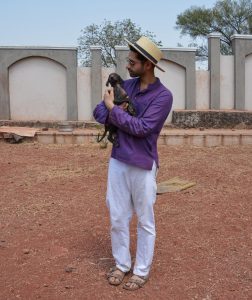 Neil Trilokekar (in photo with Caravan Hound puppy) returns for part two of this fascinating conversation with host Laura Reeves. The Caravan Hounds story is equal parts intrigue and investigative work through the mists of time, with a frisson of danger and a large helping of reverence for the common man.
Neil Trilokekar (in photo with Caravan Hound puppy) returns for part two of this fascinating conversation with host Laura Reeves. The Caravan Hounds story is equal parts intrigue and investigative work through the mists of time, with a frisson of danger and a large helping of reverence for the common man.
“First and foremost it’s a hunting dog,” Trilokekar said. “They hunt largely for hare and fox. Fox ’cause it’s a vermin and hare for food. In the old days, they would also take blackbuck which is type of gazelle, but that doesn’t really happen these days. So it’s a hunting dog, but it also is general alarm around the property. They are not aggressive. They’re not supposed to be super guardy or aggressive.
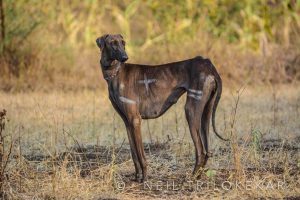 “(They are a) typical sighthound. Reserved, kind of cat-ish in their mannerisms. Personality wise, they are reserved like most Asiatic sighthounds. Most of them, they’re raised in a very rough manner, the ones that live in villages. But they still end up being very easy-going dogs. They know how to interact with the world. I’m very impressed with their characters.
“(They are a) typical sighthound. Reserved, kind of cat-ish in their mannerisms. Personality wise, they are reserved like most Asiatic sighthounds. Most of them, they’re raised in a very rough manner, the ones that live in villages. But they still end up being very easy-going dogs. They know how to interact with the world. I’m very impressed with their characters.
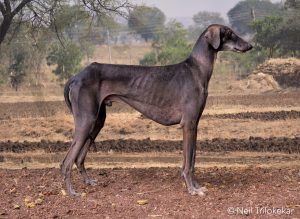 “(The Caravan Hound is) a very ‘dry’ dog. Lean dry musculature. Minimalistic in design, if you think about it that way. Very square or even slightly shorter than they are tall. Very deep chested with a really good tuck up. Not a very long loin, it’s a fairly moderate loin. The top line is fairly level more like an Afghan type top lines. Fairly level or there might be a very slight incline from the Withers up to the hip bones, not sloping down from the Withers sloping slight incline and the hip bones are prominent. Angulation is very moderate. They have very refined head. There’s two basic head types in the breed, but even what they call the more moderate head is a very refined head to begin with.
“(The Caravan Hound is) a very ‘dry’ dog. Lean dry musculature. Minimalistic in design, if you think about it that way. Very square or even slightly shorter than they are tall. Very deep chested with a really good tuck up. Not a very long loin, it’s a fairly moderate loin. The top line is fairly level more like an Afghan type top lines. Fairly level or there might be a very slight incline from the Withers up to the hip bones, not sloping down from the Withers sloping slight incline and the hip bones are prominent. Angulation is very moderate. They have very refined head. There’s two basic head types in the breed, but even what they call the more moderate head is a very refined head to begin with.
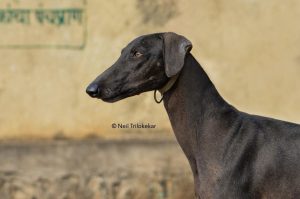 “Thin skin. The coat is a very unique coat. Nearly the only breed that I’ve felt the coat on which is kind of the same is some Shar Pei have a similar coat that they call a horse coat. That really hard bristly hair. I think some of the Chongqing Dogs might have a similar coat too. It’s very sparse. It’s almost hairless on the undersides and it looks glossy when you look at it from afar like it gleams but you touch it and it’s got like a bristly harsh feel to it. It’s a very short coat like you can see the skin through the coat. That’s definitely a very unique and prized characteristic of the breed.
“Thin skin. The coat is a very unique coat. Nearly the only breed that I’ve felt the coat on which is kind of the same is some Shar Pei have a similar coat that they call a horse coat. That really hard bristly hair. I think some of the Chongqing Dogs might have a similar coat too. It’s very sparse. It’s almost hairless on the undersides and it looks glossy when you look at it from afar like it gleams but you touch it and it’s got like a bristly harsh feel to it. It’s a very short coat like you can see the skin through the coat. That’s definitely a very unique and prized characteristic of the breed.
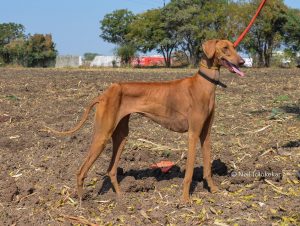 “Colours, they are usually very drab colours so they blend in with the land over which they work. They work over black cotton soil largely and so you get a lot of blacks, you get a lot of seals, shades of seal and also some of the dogs work over red soil so you get Reds and fawns and occasionally get a grey. Not blue, not a dilute like a grey, grey. Generally, a lot of old hunters and breeders, village people, they do not accept brindle and they do not accept parti colours, ’cause those are thought to have been brought in with Greyhound influence. There is not high incidence of feathered caravan hounds. Out of all the people I know and they had a meeting of 50 different people that have known the breed for years and years there was two people that have seen a feathered caravan hound born.”
“Colours, they are usually very drab colours so they blend in with the land over which they work. They work over black cotton soil largely and so you get a lot of blacks, you get a lot of seals, shades of seal and also some of the dogs work over red soil so you get Reds and fawns and occasionally get a grey. Not blue, not a dilute like a grey, grey. Generally, a lot of old hunters and breeders, village people, they do not accept brindle and they do not accept parti colours, ’cause those are thought to have been brought in with Greyhound influence. There is not high incidence of feathered caravan hounds. Out of all the people I know and they had a meeting of 50 different people that have known the breed for years and years there was two people that have seen a feathered caravan hound born.”
381 – Rare Breeds: Preservation, Promotion and Purposeful Breeding
Rare Breeds: Preservation, Promotion and Purposeful Breeding
Let’s kick off a month of Pure Dog Talk conversations, insights and ideas about rare breeds, preservation, promotion and purposeful breeding of these delightful dogs.
Today’s conversation is with Jennie Chen, breeder of Lowchen and Greater Swiss Mountain Dogs, Anna Wallace, breeder of Entlebuchers and Ian Lynch, Dandie Dinmont Terrier owner.
How to acquire a rare breed dog
Just acquiring a dog in a rare breed is one of the most difficult challenges, our panelists agreed.
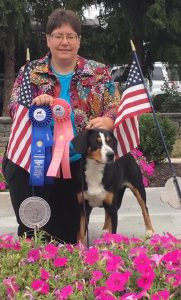
Anna Wallace and her Entlebucher
“I mean we’re absolutely protective of the dogs,” Wallace said. “So we have that aspect of ‘well we can’t keep them all we do have to place some of these puppies’ but we want to make sure they go into the right homes … can they benefit the breed in the long run… pets are very important because (they) become the ambassador the public sees … but we also don’t want to lose too much of our breeding pool in our gene pool to dogs that are going to ultimately end up neutered … so there’s a balance there and I know that’s one of the reasons it’s hard to break into (a rare breed). I actually broke in with a male ’cause it’s always easier to get a boy.”
Public education
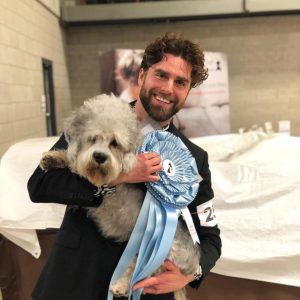
Ian Lynch with his Dandie Dinmont Terrier
Reaching the general public with information about our lesser known breeds is critical, especially younger people.
“I think a lot of times of millennials are kind of going back to our roots in a lot of ways,” Lynch said. “Like the farm to table eating, what’s old is new, what used to be called hand me downs is now called vintage clothing. I think a lot of people are really interested in history and I really liked the idea of being able to help a breed that needed a hand. I mean they say this in a lot of ways, that you could go to a shelter and you can save one dog or you can buy a rare breed, an endangered species. and save a whole breed of dog, the whole history of this dog can be saved.”
Social media
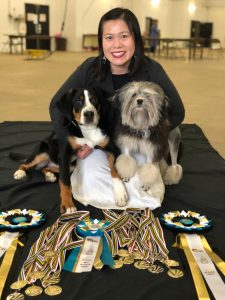
Jennie Chen with her Greater Swiss Mountain Dog and Lowchen.
Social media, particularly Instagram, including Facebook and Twitter, are great resources for reaching potential new owners. Our panelists agreed that young folks buy from social media and we need to reach potential owners where they are.
“I actually started in social media a little bit by accident,” Chen said. “’cause when I got my first greater Swiss mountain dog, I studied psychology and I’m all into early neurological stimulation early neurological training critical periods, I started *Keep Austin Dog Friendly… it is a list of restaurants in Austin TX where you could take your dog … I would go take my dogs out and I still do that today for socialization, for training and all that sort of stuff, and that website got really, really big … my dog became the face of *Keep Austin dog friendly… the website is still up … I even turned one of our website events into (my dog’s) birthday party … I use Instagram now quite a bit. A lot of my homes… create an Instagram specifically for the dog. I don’t have to get photos via email, they’re available all the time on my phone.”
Listen to the podcast for more insights, ideas and guidance from our outstanding panelists.

